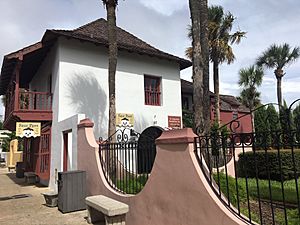Marin-Hassett House facts for kids
The Marin-Hassett House is a special old building located at 97 St. George Street in St. Augustine, Florida. It was rebuilt on top of its original foundations, which date all the way back to St. Augustine's First Spanish Period.
Contents
A Look Back: History of the House
Imagine a long time ago, during St. Augustine's First Spanish Period (from 1565 to 1763). A one-story house stood right here. Later, in the 1800s, a second floor and a wooden back part were added. The house is mostly built from a unique stone called coquina, which is made of tiny shell fragments. This stone was then covered with plaster to seal it.
Right next to the Marin-Hassett House, you'll find the Hispanic Garden. This garden is a beautiful copy of a traditional Spanish garden. It even has a bronze statue of Queen Isabella, created by a famous artist named Anna Hyatt Huntington.
The original stone house belonged to a woman named Antonia Marin. When Florida was under British rule, a man named James Box bought the house. After him, Stephen Haven owned it. Then, during the Second Spanish Period in 1787, a kind Irish priest named Father Thomas Hassett bought the property. Father Hassett was very important to the Minorcan community in St. Augustine. He also started the very first free school in what would later become the United States!
Bringing the House Back to Life: Restoration Efforts
In the 1960s, there was a big project to restore old buildings in downtown St. Augustine. Senator George Smathers was a key person in this effort. He was part of President John F. Kennedy's special commission for St. Augustine's 400th birthday in 1965. Senator Smathers invited the Pan American Union to join in. The idea was to have countries from Latin America share their culture through exhibits and music for the celebration.
President Kennedy thought this project was very important. He compared it to Colonial Williamsburg in Virginia, which shows early American history. He said it would be a "symbol of the cultural heritage" from Hispanic-American countries and Spain. He believed it would create a strong bond with these neighbors.
A group called St. Augustine Restoration Inc. bought the property where the house stood. They used money donated by American companies that did business in Latin America, like Ford, General Motors, and Texaco. It cost about $25,000 to buy the land and another $27,066 to rebuild the Marin-Hassett House.
The restored house became the Pan American Center. Earle Newton was its first director, followed by Dr. Carlton Calkin. The center displayed amazing art from Hispanic cultures. It was meant to work alongside other cultural centers in St. Augustine.
On April 24, 1965, representatives from many countries in the Organization of American States gathered for a special ceremony. They included people from Argentina, Brazil, Colombia, Costa Rica, and the United States, among others.
The Pan American Center often showed religious statues from the 1600s to 1800s, especially during Christmas. These statues came from places like Mexico, Ecuador, and Peru. The center even had a three-foot statue of Saint Augustine himself! Many statues were painted and covered with a plaster-like material called gesso. In 1968, the center displayed a replica of an ancient mummy found in Peru, as part of a special exhibit about the Paracas culture. Most of the items on display, like pottery, gold jewelry, and textiles, came from ancient tombs. The oldest item was a woven textile from Peru, dating back to 600 B.C.E. (that's over 2,600 years ago!).
The Beautiful Hispanic Garden
In the late 1700s, Father Hassett used the land south of the house to grow vegetables and fruit trees. Many years later, in the mid-1900s, this same area was turned into a beautiful garden once again. It connected the house to the Spanish Exhibition Center across the street. The garden was made possible by a generous gift from Jessie Ball duPont, along with help from garden clubs and other groups. The Women’s Garden Clubs of Florida did all the amazing landscaping work.
The Marin-Hassett House Today
Today, the downstairs part of the Marin-Hassett House is a retail space. It's currently home to a dog store called Faux Paws. The upstairs is used by the St. Augustine Foundation Inc. The entire building is owned by the St. Augustine Foundation, Inc.


